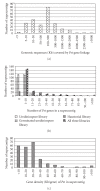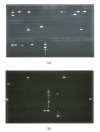Constructing Physical and Genomic Maps for Puccinia striiformis f. sp. tritici, the Wheat Stripe Rust Pathogen, by Comparing Its EST Sequences to the Genomic Sequence of P. graminis f. sp. tritici, the Wheat Stem Rust Pathogen
- PMID: 20169145
- PMCID: PMC2821759
- DOI: 10.1155/2009/302620
Constructing Physical and Genomic Maps for Puccinia striiformis f. sp. tritici, the Wheat Stripe Rust Pathogen, by Comparing Its EST Sequences to the Genomic Sequence of P. graminis f. sp. tritici, the Wheat Stem Rust Pathogen
Abstract
The wheat stripe rust fungus, Puccinia striiformis f. sp. tritici (Pst), does not have a known alternate host for sexual reproduction, which makes it impossible to study gene linkages through classic genetic and molecular mapping approaches. In this study, we compared 4,219 Pst expression sequence tags (ESTs) to the genomic sequence of P. graminis f. sp. tritici (Pgt), the wheat stem rust fungus, using BLAST searches. The percentages of homologous genes varied greatly among different Pst libraries with 54.51%, 51.21%, and 13.61% for the urediniospore, germinated urediniospore, and haustorial libraries, respectively, with an average of 33.92%. The 1,432 Pst genes with significant homology with Pgt sequences were grouped into physical groups corresponding to 237 Pgt supercontigs. The physical relationship was demonstrated by 12 pairs (57%), out of 21 selected Pst gene pairs, through PCR screening of a Pst BAC library. The results indicate that the Pgt genome sequence is useful in constructing Pst physical maps.
Figures



Similar articles
-
Gene discovery in EST sequences from the wheat leaf rust fungus Puccinia triticina sexual spores, asexual spores and haustoria, compared to other rust and corn smut fungi.BMC Genomics. 2011 Mar 24;12:161. doi: 10.1186/1471-2164-12-161. BMC Genomics. 2011. PMID: 21435244 Free PMC article.
-
Wheat stripe (yellow) rust caused by Puccinia striiformis f. sp. tritici.Mol Plant Pathol. 2014 Jun;15(5):433-46. doi: 10.1111/mpp.12116. Mol Plant Pathol. 2014. PMID: 24373199 Free PMC article. Review.
-
An Avirulence Gene Cluster in the Wheat Stripe Rust Pathogen (Puccinia striiformis f. sp. tritici) Identified through Genetic Mapping and Whole-Genome Sequencing of a Sexual Population.mSphere. 2020 Jun 17;5(3):e00128-20. doi: 10.1128/mSphere.00128-20. mSphere. 2020. PMID: 32554716 Free PMC article.
-
Stage-specific gene expression during urediniospore germination in Puccinia striiformis f. sp tritici.BMC Genomics. 2008 May 1;9:203. doi: 10.1186/1471-2164-9-203. BMC Genomics. 2008. PMID: 18447959 Free PMC article.
-
Alternate Hosts of Puccinia striiformis f. sp. tritici and Their Role.Pathogens. 2020 Jun 2;9(6):434. doi: 10.3390/pathogens9060434. Pathogens. 2020. PMID: 32498285 Free PMC article. Review.
References
-
- Stubb RW. Stripe rust. In: Roelfs AP, Bushnell WR, editors. Cereal Rusts: Diseases, Distribution, Epidemiology, and Control. Vol. 2. New York, NY, USA: Academic Press; 1985. pp. 61–101.
-
- Chen XM. Epidemiology and control of stripe rust [Puccinia striiformis f. sp. tritici] on wheat. Canadian Journal of Plant Pathology. 2005;27(3):314–337.
-
- Chen XM, Ling P. Towards cloning wheat genes for resistance to stripe rust and functional genomics of Puccinia striiformis f. sp. tritici . In: Proceedings of the 11th International Cereal Rusts and Powdery Mildew Conference; August 2004; Norwich, England. Cereal Rusts and Powdery Mildews Bulletin;
LinkOut - more resources
Full Text Sources
Research Materials

